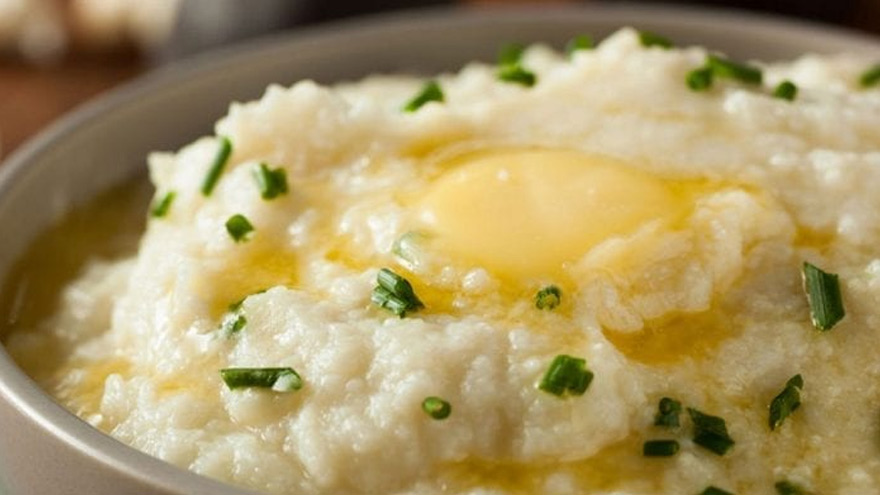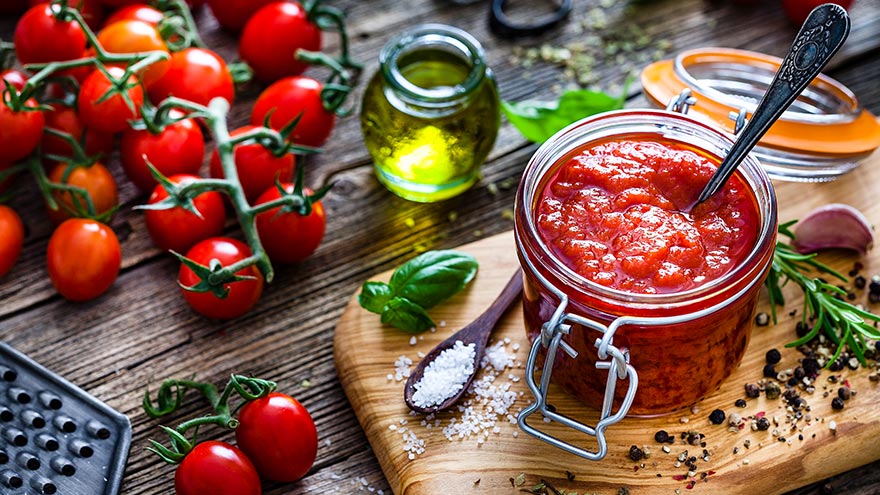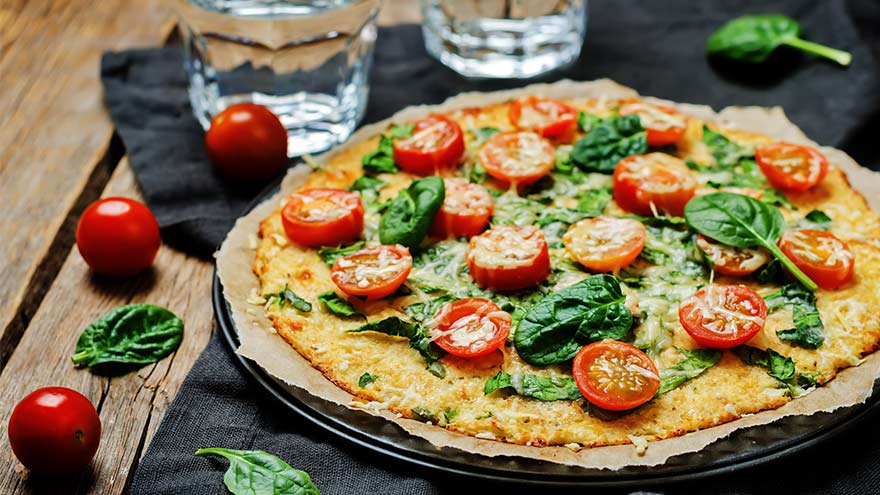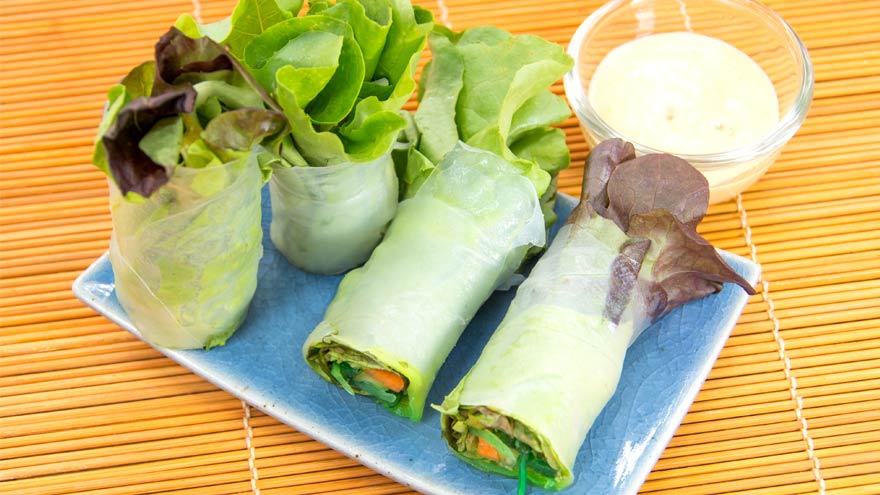Search
-
Get Spicy! Try This Easy Heart-Healthy Vegan Paella
Enjoy the heartiness of traditional paella without any added salt or meat. This recipe is also low in fat, making it a good heart-healthy choice for lowering cholesterol and blood pressure.
Read More About Get Spicy! Try This Easy Heart-Healthy Vegan Paella
-
Make Your Own Trail Mix: 4 Quick and Easy Recipes
Craving a snack with crunch, sweet flavor and a powerful nutritious punch? These healthy, homemade variants of this make-it-and-take-it super snack are sure to satisfy your sweet tooth and your healthy lifestyle. Who says healthy snacks and bland taste go together? We say you can have it all — nutritious and delicious snack foods that taste great and satisfy — and trail mix fits the bill. Your homemade batch can be as healthy as you like. The nuts provide fiber, protein and a whole lot of crunchy goodness; dried fruit and touches of chocolate infuse the mix with just the right amount of sweetness. We’ve compiled some simple-to-make and hard-to-resist recipes so you can easily pick up a few items from the grocery store’s bulk bins, or your kitchen cupboard, and put together a snack for your kiddos lunches or the office. Better yet, grab your mix and head out for a stroll or hike, or take along on your next road trip or adventure in Nevada’s rugged, desert locales.
Read More About Make Your Own Trail Mix: 4 Quick and Easy Recipes
-
3D vs Whole Breast Ultrasound Which is Right for You
Breast cancer is the leading cause of cancer deaths in women in the U.S. That’s why early detection is so important. Dr. George Krakora, a radiologist with Renown Institute for Cancer, explains what to watch for and how new technology can lead to early detection. Most women know the importance of breast health and staying current with annual breast exams, but may not know that both screening guidelines and technology is evolving. So we asked George Krakora, MD, a radiologist for the Renown Institute for Cancer, what every woman should know about breast cancer detection and which screening method is right for them. First off, when should women start getting breast exams? Generally, women should start getting breast exams using mammography or ultrasound after they turn 40 years old. But we also want women ages 18 to 39 to talk to their primary care provider and ask for what’s called a formal risk assessment to see if screening is needed sooner. And you want to make sure your care provider is giving you a breast exam starting at age 25. It’s also a good idea to be familiar with how your breasts look and feel so you can report any changes to your care provider. What are the risk factors for breast cancer? Are there any preventive steps women can take? There a few risk factors you can’t control, like your age, family history of breast or other cancers, and if you have dense breast tissue. Your risk for breast cancer increases as you get older, and most breast cancers are diagnosed after age 50. Knowing your family history is important because a history of cancer and shared lifestyle can raise your risk. Your breast density can also increase your risk: Women with high breast density are four-to-five times more likely to get breast cancer than women with low breast density. But the good news is there are quite a few things you can do to prevent breast cancer, like not smoking, watching your alcohol intake, and maintaining a healthy weight with good diet and exercise. There are a lot of newer screenings out today. What is the difference between 2-D and 3-D mammography? In a 2-D mammogram, the tech takes X-rays of the breast. These pictures can show the radiologist if there are any lumps or tumors you might not be able to feel. In 3-D mammography, the process is largely the same but more X-rays are taken and it takes a few seconds longer for each image. This kind of exam detects 41 percent more cancers and reduces the number of false-positive results given to patients. This improvement in technology is great for both patients and their care providers. 3-D mammography provides better images of the breast, which allow doctors to more clearly diagnose and avoid false positives, especially in women with dense breast tissue. And what about a whole breast ultrasound. What is that? A whole breast ultrasound uses sound waves to detect cancerous tumors in the breast without using any radiation — it’s an ultrasound just like pregnant women get to check up on their baby. And the exam only takes about 20 minutes. We recommend these exams for patients whose mammograms have shown that they have dense breast tissue. Dense breast tissue can make it harder for doctors to see any abnormalities, lumps or tumors in a mammogram, so this technology ensures better early detection.
Read More About 3D vs Whole Breast Ultrasound Which is Right for You
-
Slow Cooker Paleo Chili
Nothing says comfort like a bowl of chili. This rich, flavorful dish is Paleo-diet friendly and ready to eat when you are.
-
Paleo Garlic Mashed No-Tatoes
This scrumptious mashed potato substitute is super easy, tasty and gluten-free.
-
DIY Heart-Healthy Marinara Sauce
The convenience of marinara sauce in a jar is pretty hard to beat. But with some extra time in the kitchen, the nutritional value of traditional sauce — already packed with good stuff — goes off the charts.
-
Meatless Monday: Black Bean Tostadas
Research shows that plant-based diets can help manage — and in some cases aid — in the prevention of many chronic conditions such as diabetes, heart disease and even cancer. If you’re looking to adopt a healthier lifestyle, try incorporating more plant-based and meatless recipes into your diet — even if it’s just once a week. If you want to cut back on meat but not flavor, we’ve got you covered with this black bean tostada recipe. The list of ingredients includes a number of veggies and spices that are not only good for you, but will make your taste buds sing. The best part? This delicious, Mexican-style dish is so easy that even the most novice cook can have dinner served in just 15 minutes. Enjoy!
-
Super Easy Seared Salmon & Spring Salad
Watch Renown Chef Chris Wyatt blend zest and spice in this seared salmon and grilled veggie dish with a few secret ingredients. Are you looking for a new twist on an old stand-by dinner favorite while getting a heart-healthy dose of omega-3s? Look no further: Salmon recipes don’t get any easier than this. With this mouth watering recipe totaling in at just less than 350 calories, done in nearly 30 minutes, you’re going to want to make it your next meal. Added perk: Eating fish, such as salmon, twice a week has been found to lower the risk of heart attack and stroke over fish oil supplements.
-
Low Salt, Big Flavor! Spicy Oven-Fried Chicken
Looking for a low-sodium recipe that delivers high marks for taste? Try this Heart Association-approved recipe for oven fried chicken. Diets high in sodium can increase blood pressure, putting you at greater risk for stroke. But you don’t have to trade taste for better health. Take this recipe from the American Heart and Stroke Association: With spicy cayenne, tangy dry mustard and smoky paprika, you won’t miss the salt in this lightened-up southern classic.
Read More About Low Salt, Big Flavor! Spicy Oven-Fried Chicken
-
Meatless Monday: Easy Gluten-Free Cauliflower Crust Pizza
Research shows that plant-based diets can help manage and even aid in the prevention of many chronic conditions such as diabetes, heart disease and cancer. Try incorporating more plant-based and meatless recipes into your diet — even if it’s just once a week. Here’s a delicious and easy pizza recipe to get you started. Cauliflower is finally getting its due. This nutritional powerhouse of a veggie is flying off the shelves as a low-carbohydrate substitute for grains and legumes. Why? The seemingly boring, white veggie is rich in antioxidants, nutrients, fiber and weighs in at just 25 calories per cup. And it’s great at camouflaging as rice, or in this case, as a base for pizza crust.
Read More About Meatless Monday: Easy Gluten-Free Cauliflower Crust Pizza
-
Early Onset of Puberty in Girls on the Rise
Many factors are contributing to the rise of early onset puberty in girls. Learn what they are below and how you can support your daughter. The number of girls experiencing early puberty has increased dramatically over the last few years and continues to grow. More and more girls in the U.S. are starting to show signs of development before the age of 8. Recent studies show that up to 10 percent of Caucasian girls and 23 percent of African American girls are showing signs of puberty by age 7. What’s Contributing to Early Puberty in Girls? Determining the exact cause is difficult. But experts agree that several factors may be contributing to these growing numbers. Increasing rates of childhood overweight and obesity. Excess body fat alters the levels of hormones responsible for the acceleration of pubertal timing. Physical inactivity may decrease melatonin levels, which can also trigger pubertal development. Increased animal protein intake. Higher total protein, animal protein and meat intake in children ages 3 to 7 have been associated with earlier onset of menstruation. High protein intake elevates IGF-1 levels and promotes growth, which could accelerate the onset of puberty. Poor diet. Children with lower-nutrient diets tend to enter puberty earlier. A diet rich in processed foods and meats, dairy, and fast food is disruptive to normal physical development. Exposure to EDCs (endocrine-disrupting chemicals). EDCs are synthetic chemicals found in plastics, pesticides, fuels and other industrial chemicals that inhibit or alter the action of natural hormones. Because EDCs accumulate in the fatty tissues of animals, animal foods contain higher levels of these chemicals than plant foods. Exposure to BPA (bisphenol A). BPA is an industrial petrochemical found in a variety of products including plastics, tin-can linings and even cash register receipts. Because it acts as a synthetic estrogen it may speed up pubertal development. Soy products. Soy contain isoflavones which are converted to phytoestregens in the body, and are similar to the hormone estrogen, Dr. Chelsea Wicks says. “Soy consumed from natural food sources is likely safe and will not cause abnormal hormones levels. However, when consumed in large amounts, such as with soy supplements or in more processed foods, there have been links to chronic medical problems due to elevated estrogen levels. I feel a good answer to this is to continue working on eating fresh foods and trying to avoid the processed, packaged foods as this will be best for overall general nutrition as well,” she adds. What You Can Do While some genetic factors play a role in the early onset of puberty, parents can help lessen environmental causes of the condition. Encourage and help your child to maintain a healthy weight with proper nutrition and exercise. Avoid exposure to hormones such as estrogen and testosterone that may be found in hair products, medications and nutritional supplements. Avoid exposure to EDCs and BPA. Offer your child a diet centered around whole plant foods rather than animal foods, which will help keep protein intake within a safe range and reduce consumption of EDCs. Create a supportive environment for your daughter. Avoid commenting on her appearance and instead focus on her achievements, academic successes or artistic talents. Speak to her openly and honestly about the physical changes she’s experiencing — that although these changes are normal, she’s simply developing early — and that ultimately her peers will undergo the same changes. Encourage your daughter to continue participating in social activities and pursuing her interests, and reassure her you are always open to discuss any questions or worries. If you are concerned that your child may be going through these changes before expected, speak with your pediatrician. Sources: Early Puberty: Causes and Consequences When Is Puberty Too Early? Precocious Puberty (Early Puberty) Precocious Puberty
-
Lighten Up With Healthy Shrimp Avocado Spring Rolls
The longer days of spring bring us more daylight and more hours to enjoy the sun. At dinnertime, we’re craving something lighter than the heavy stews and dishes of winter. Lighten up your palate for spring and usher in the new season — without sacrificing taste — with these do-it-yourself spring rolls. And with no cooking required, kids can roll up their sleeves and easily join the fun.
Read More About Lighten Up With Healthy Shrimp Avocado Spring Rolls











